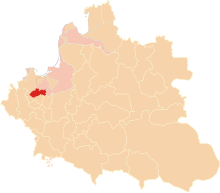Chełmno Voivodeship
This article does not cite any sources. (December 2009) |
| Chełmno Voivodeship Palatinatus Culmensis Województwo chełmińskie | |||||||||
|---|---|---|---|---|---|---|---|---|---|
| Voivodeship of Poland¹ Part of Royal Prussia (until 1772) | |||||||||
| 1466–1793 | |||||||||
 Coat of arms
| |||||||||
 Chełmno Voivodeship of the Polish–Lithuanian Commonwealth | |||||||||
| Capital | Chełmno | ||||||||
| Area | |||||||||
• | 4,654 km2 (1,797 sq mi) | ||||||||
| History | |||||||||
• Prussian uprising | 1454 | ||||||||
| 9 October 1466 | |||||||||
| 1569 | |||||||||
| 1772 | |||||||||
| 1793 | |||||||||
| Political subdivisions | Two lands divided into 7 counties | ||||||||
| |||||||||
| ¹ Voivodeship of the Polish Crown in the Polish–Lithuanian Commonwealth; Voivodeship of the Kingdom of Poland before 1569. | |||||||||
The Chełmno Voivodeship (Polish: Województwo chełmińskie) was a unit of administrative division and local government in the Kingdom of Poland since 1454/1466 until the Partitions of Poland in 1772/1795. Together with the Pomeranian and Malbork Voivodeships and the Prince-Bishopric of Warmia it formed the historical province of Royal Prussia. Its capital was at Chełmno (German: Kulm).
History[]

The Land of Chełmno (later known in German as Kulmerland) had been part of the Polish Duchy of Masovia since 1138. It was occupied by pagan Old Prussian tribes in 1216, who struggled against their Christianization instigated by Bishop Christian of Oliva. After several unsuccessful attempts to reconquer Chełmno, Duke Konrad I of Masovia in 1226 called for support by the Teutonic Knights, who indeed approached and started a Prussian campaign, after the duke promised them the unshared possession of the Chełmno territory as part of the Order's State.
In the course of the Order's decline after the 1410 Battle of Grunwald, the citizens of Chełmno, Toruń (Thorn) and Lubawa (Löbau) joined the uprising of the Prussian Confederation, which sparked the Thirteen Years' War between the Knights and the Kingdom of Poland. After the Order's defeat, the Chełmno Land fell back to Poland according to the Second Peace of Thorn and together with the adjacent Michelauer land in the east formed the Chełmno Voivodeship of the Polish Crown, since the 1569 Union of Lublin part of the Polish–Lithuanian Commonwealth.
The voivodeship was annexed by Prussia during the First Partition of Poland in 1772, except for the city of Toruń, which was not incorporated into the Province of West Prussia until the 1793 Second Partition.
Administration[]
Voivodeship Governor (Wojewoda) seat:
Regional council (sejmik generalny)
Regional councils (sejmik poselski i deputacki)
Administrative division:
- Chełmno Land, (Ziemia Chełmińska), Chełmno
- Chełmno County, (Powiat Chełmiński), Chełmno
- Toruń County, (Powiat Toruński), Toruń
- Grudziądz County, (Powiat Grudziądzki), Grudziądz
- , (Powiat Radzyński), Radzyń
- , (Powiat Kowalewski), Kowalewo
- Michałowo Land, (Ziemia Michałowska), Lubawa
- Brodnica County, (Powiat Brodnicki), Brodnica
- Nowe Miasto County, (Powiat Nowomiejki), Nowe Miasto Lubawskie
Voivodes[]
- , 1454-1455
- , 1455-1474
- , 1475-1480
- , 1480-1483
- , 1484-1495
- Jan Dąbrowski, 1498-1513
- , 1514-1551
- Stanisław Kostka, 1551-1555
- , 1556-1583
- , 1584-1604
- , 1605-1611
- , 1611-1615
- , 1615-1615
- , 1618-1626
- Melchior Wejher, 1626-1643
- Mikołaj Wejher, 1643-1647
- Jan Działyński, 1647-1648
- , 1648-1662
- , 1663-1668
- Jan Gniński, 1668-1680
- , 1681-1687
- ,1688-1702
- , 1702-1714
- , 1714-1725
- Franciszek Bieliński, 1725-1732
- 1732-1738
- , 1738-1746
- , 1746-1766
- Franciszek Stanisław Hutten-Czapski, 1766-1802
References[]
Coordinates: 53°20′58″N 18°25′27″E / 53.349558°N 18.424220°E
- States and territories established in 1466
- States and territories disestablished in 1793
- Voivodeships of the Polish–Lithuanian Commonwealth
- Royal Prussia
- 1466 establishments in Europe
- 15th-century establishments in Poland
- 1793 disestablishments in the Polish–Lithuanian Commonwealth
- Polish history stubs

